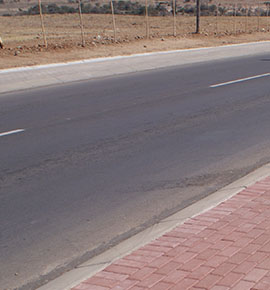Technicrete - Manufacturing concrete products in the mining and construction industries in South Africa.
This kerb has the most commonly used ‘Half-battered’ profile. This more vertical face offers a type of ‘barrier’ to motorists sufficient for them to be aware that they are dangerously close to the edge.
This kerb has the most commonly used ‘Half-battered’ profile. This more vertical face offers a type of ‘barrier’ to motorists sufficient for them to be aware that they are dangerously close to the edge.
This kerb has an almost flat surface with a 25mm difference across its 300mm width and is typically used for traffic calming measures or in conjunction with other kerbs
This is a low level bull-nosed edge restraint normally used at bus lane stops for ease of entry onto BRT busses.
This kerb is a light to medium duty bull-nosed edge restraint normally used around islands in parking areas with light traffic conditions.
This kerb is normally used in light duty edge restraint along path ways. The kerb is installed flush with the pavement and is only concreted should there be any vehicle traffic onto the pathway.
A medium load duty kerb, typically used in residential developments, with a very sloped profile that allows vehicles to encroach onto it without damaging tires and wheels.
A heavy load duty kerb, typically used in commercial / industrial developments. This type of kerb can be used in conjunction with Barrier Kerbs.
Precast Concrete Kerbs, A range of precast concrete kerbs for use as an edge restrain in the construction of roads footpaths, parking areas and various applications.
This kerb has the ‘Splayed’ profile which is preferred in those situations where a vehicle may need to ‘bump up’ onto a verge in an emergency.
This kerb is used for light to medium duty edge restraint along walkways and in drive ways to form a permanent but moveable (not fixed) edge along a paved area. This kerb is machine pressed and is normally not used as a barrier kerb.



This kerb has the most commonly used ‘Half-battered’ profile. This more vertical face offers a type of ‘barrier’ to motorists sufficient for them to be aware that they are dangerously close to the edge.
This kerb has the most commonly used ‘Half-battered’ profile. This more vertical face offers a type of ‘barrier’ to motorists sufficient for them to be aware that they are dangerously close to the edge.
This kerb has an almost flat surface with a 25mm difference across its 300mm width and is typically used for traffic calming measures or in conjunction with other kerbs
This is a low level bull-nosed edge restraint normally used at bus lane stops for ease of entry onto BRT busses.
This kerb is a light to medium duty bull-nosed edge restraint normally used around islands in parking areas with light traffic conditions.
This kerb is normally used in light duty edge restraint along path ways. The kerb is installed flush with the pavement and is only concreted should there be any vehicle traffic onto the pathway.
A medium load duty kerb, typically used in residential developments, with a very sloped profile that allows vehicles to encroach onto it without damaging tires and wheels.
A heavy load duty kerb, typically used in commercial / industrial developments. This type of kerb can be used in conjunction with Barrier Kerbs.
Precast Concrete Kerbs, A range of precast concrete kerbs for use as an edge restrain in the construction of roads footpaths, parking areas and various applications.
This kerb has the ‘Splayed’ profile which is preferred in those situations where a vehicle may need to ‘bump up’ onto a verge in an emergency.
This kerb is used for light to medium duty edge restraint along walkways and in drive ways to form a permanent but moveable (not fixed) edge along a paved area. This kerb is machine pressed and is normally not used as a barrier kerb.